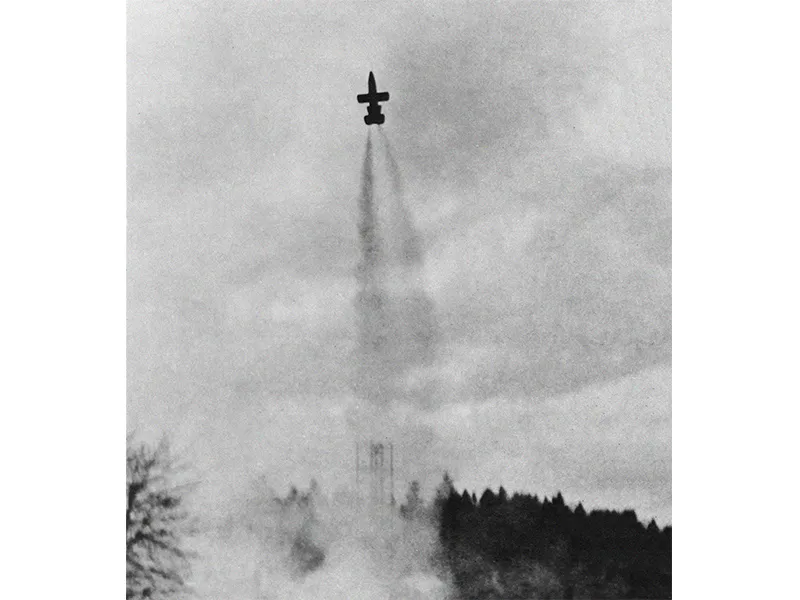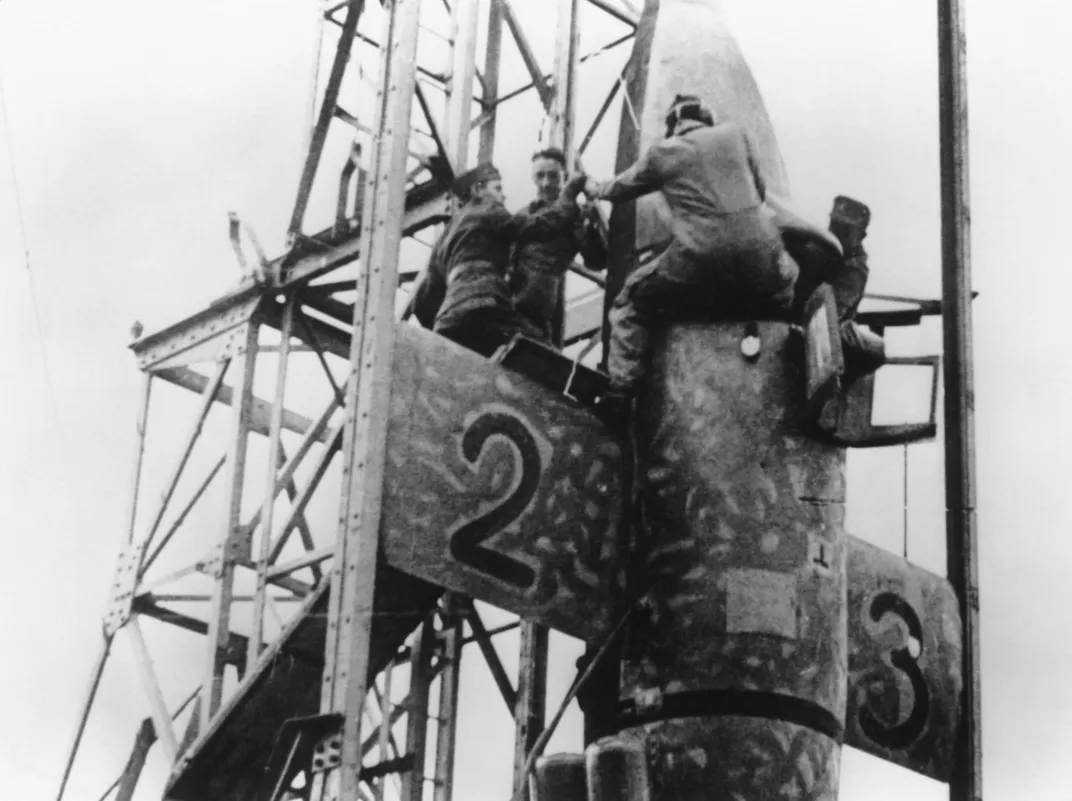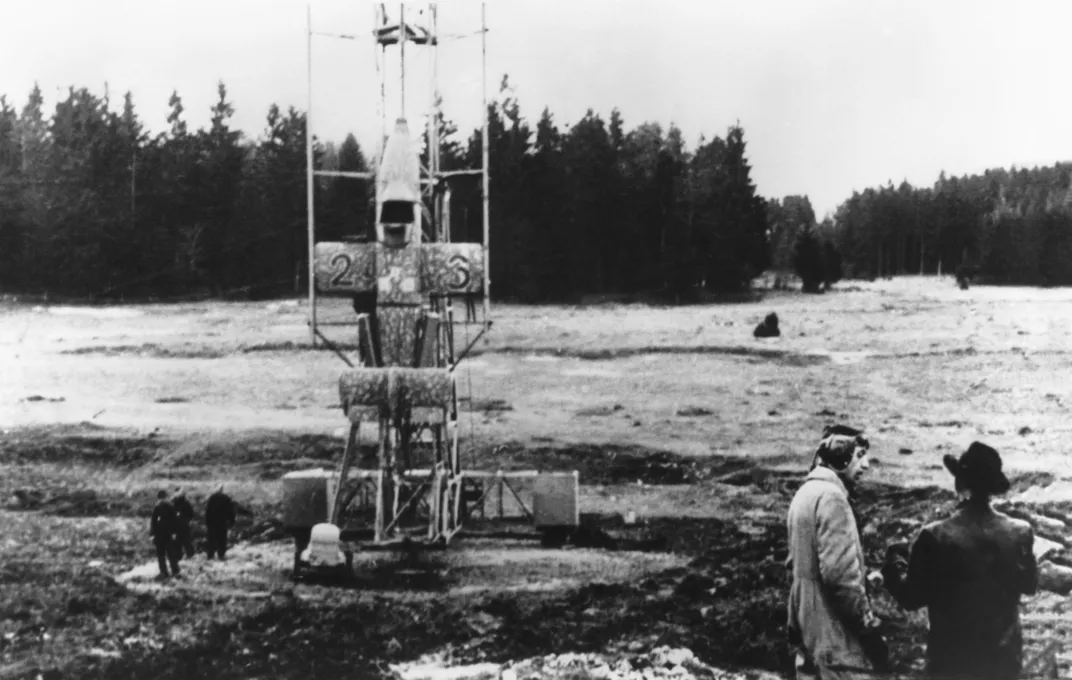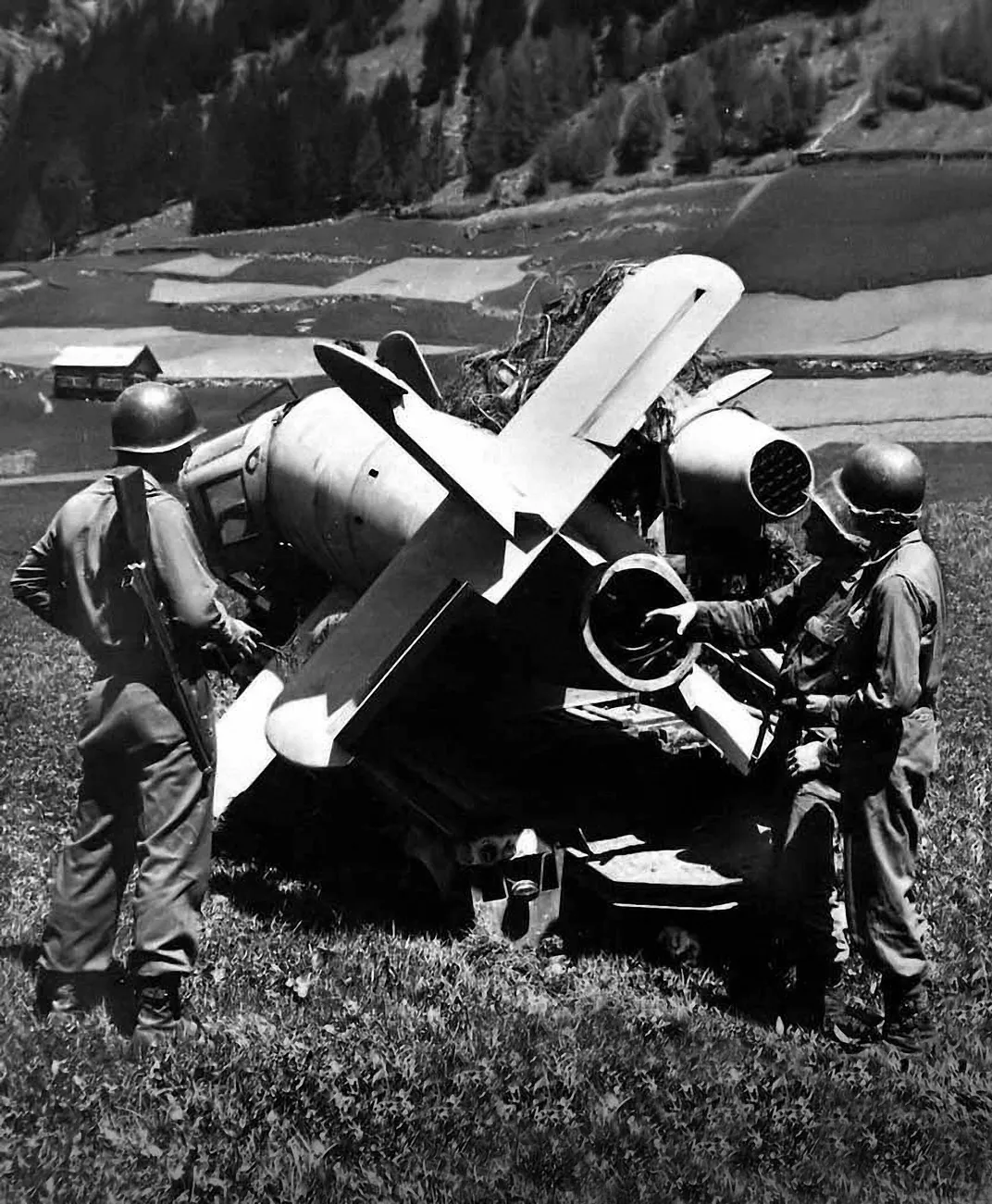World War II’s Worst Airplane
The product of an ambitious designer and a doomed regime, the Bachem Ba 349 Natter was a radical idea that almost worked.
/https://tf-cmsv2-smithsonianmag-media.s3.amazonaws.com/filer/3d/f8/3df85d58-ae40-499b-83cc-0695b85b9e84/nattercockpit.jpg)
On March 1, 1945, a young test pilot became the first human to lie on his back and wait for a rocket engine to blast him toward the heavens. Like those who would dare ride the fire after him, he believed in his cause and was confident in the success of his mission. He was mistaken on both counts. The development of the aircraft he was “piloting” is one of the more bizarre stories of the last desperate days of the Third Reich, but it began long before the Nazi war machine had collapsed, with a proposal from Wernher von Braun.
In 1937, von Braun developed a concept for a rocket-powered interceptor that would launch vertically, attack Allied bombers, and glide to a landing. Two years later, he submitted his proposal to the Luftwaffe’s Ministry of Aviation (RLM), and the ministry responded with a sincere nein thanks. In 1941, von Braun tried again—same proposal, same ministry, same answer: “We’ll call you.” The ministry’s reviewers had assessed the concept as “unnecessary and unworkable,” but the idea circulated around the German aircraft industry, reaching the company Gerhard Fieseler Werke (later known for the Fieseler Storch and the V-1 buzz bomb). Fieseler’s technical director—Erich Bachem—thought a vertically launched interceptor was a capital idea.
Three very long years later, Bachem had his own company, the Bachem-Werke GmbH, a supplier of spare parts for the manufacturers of combat airplanes. But Bachem never forgot the idea for a rocket-powered interceptor, and in the summer of 1944, he saw his opportunity to build one.

In February of that year, the Allies intensified the bombing of German cities and of the country’s aviation industry, forcing the Luftwaffe into the air to fight. The air campaign was costly to both sides, but the United States and Great Britain were able to replace the aircraft they lost; the Germans were not. With strategic supplies for the German war effort extremely tight, the RLM issued requirements that July for an inexpensive fighter to be made of non-essential materials that, with the least expenditure of effort, would bring down enemy bombers and defend important strategic targets.
In August, German industrialists Junkers, Heinkel, and Messerschmitt submitted plans. And so did Bachem. According to David Myhra, author of a series of books on Germany’s World War II experimental aircraft, the staff of the air ministry’s technical division reviewed Bachem’s uninvited submission, with its simple plans for a rocket interceptor made of wood pieces nailed together, and laughed him out of the room. But Bachem had connections—made perhaps through his work on the V-1 terror weapon—and through them, he presented his idea to Germany’s most sociopathic and least aeronautically discerning powerbroker: the head of the Nazi SS, Heinrich Himmler.
Bachem’s pitch included visions of missile-laden plywood rocketships built on the cheap by former furniture makers working in meagerly equipped shops. The aircraft, flown by minimally trained pilots who had only to guide the craft during the last few seconds of flight, would be launched en masse toward the hundreds of invading bombers that by that time were meeting little resistance from conventional Luftwaffe fighters. And the interceptors would be disposable! No gliding to an airbase—each pilot would bail out after flinging the two dozen high-explosive rockets carried in the airplane’s nose, then the airplane would crash. Himmler loved it. He ordered 150.
“The SS under Himmler’s leadership felt it was the true representative of national socialism,” says Michael Neufeld, a senior curator at the National Air and Space Museum and author of the biography Von Braun: Dreamer of Space, Engineer of War. “They believed they were really the organization that was going to save Germany from disaster and began funding a lot of strange projects.”
Himmler’s approval, in turn, forced the hand of the RLM, which didn’t like the idea of the powerful security forces horning in on their aviation turf. They reluctantly signed off on the concept they had been saying no to for half a decade and bought 50 more. Bachem got a contract, and his airplane got a name—Natter, German for viper.
With an order for 200 Natters in hand, Bachem returned to his factory in Waldsee (about 100 miles west of Munich). The SS showed up soon after, to keep an eye on the Natter’s 300 engineers and factory workers and to “recruit” support from the nearby population in the form of materials, food, fuel, and transportation.

In just a few months—by November 1944—Natter prototypes were ready for wind tunnel and flight testing. One reason for the program’s rapid progress—besides its highly motivated workforce—was that the vehicle was drop-dead simple to make. The Natter’s wings were rectangular slabs of timber with no slats, flaps, or ailerons. Its 18.7-foot-long fuselage was unremarkable other than the firing system for the 24 air-to-air missiles stuffed in its nose. The cockpit was cramped and carried minimal instrumentation. The closest thing to elegance in engineering appeared in the Natter’s cruciform tail, where the control surfaces on the four fins acted in concert to provide yaw, pitch, and roll control.
The HWK 109-509 liquid-fuel rocket engine—the same that powered the Messerschmitt Me 163 Komet fighter—was designed by Hellmuth Walter, an engineer who invented submarine and torpedo engines and later worked for the British navy. The HWK engine generated about 3,700 pounds of thrust, not enough to launch a loaded Ba 349. Bachem’s team bolted four Schmidding solid-fuel rockets to the aft fuselage to provide more oomph for the first critical 10 seconds of flight.
Team Natter carried out the first flight test on November 3, 1944, when a prototype glider was carried aloft behind a Heinkel He 111. Several towed and free-flight glide tests followed over the next two months. Although there were several close calls, the Natter was judged to have excellent flying characteristics.
On December 18, the team attempted the first unpiloted vertical launch at a pad in Heuberg, about 40 miles west of Waldsee. The wooden interceptor, with wingtips and ventral fin sliding along guide rails, got stuck halfway up the 79-foot launch tower and burned like the kindling it was made of. More unmanned vertical launches were conducted over the next three months with Natters flying off course, blowing up, and generally behaving atrociously. Then, on February 25, 1945, a Natter bearing serial number M22 lifted off with a dummy pilot and performed the entire mission sequence. After leaving the tower, the aircraft climbed for 10 seconds then received autopilot steering guidance from a ground radio, and climbed another 30 seconds to the altitude at which it would encounter bombers—about 20,000 feet. In a real mission, the pilot would have then jettisoned the nose cone and fired the rockets. Fuel expended (after 80 seconds), the Natter would have entered a dive, and at 4,500 feet, the pilot would have fired explosive bolts to jettison the entire nose section. He would have also released a braking parachute from the rear fuselage. The sudden deceleration was designed to throw the pilot from the vehicle. He would then open his own parachute for landing.
After M22’s success, Himmler wanted piloted tests ASAP. Although Bachem felt he needed more time before strapping a human into a Natter cockpit, the next launch, M23, would be Lothar Sieber’s.
The young Dresden native once shook the hand of Luftwaffe commandant Hermann Göring at a rally in Dresden in 1936 and ever afterward wanted only to fly—which he did quite well until one evening in 1943, when he was busted for drinking on duty.
Demoted to corporal, Sieber began a two-year odyssey to regain his officer’s rank and his self-respect. He flew hazardous, secret missions, including one to penetrate deep behind enemy lines on the Eastern Front to evacuate a group of German officers who had been encircled by Soviet troops. The deed earned him an Iron Cross but no promotion.
Sieber was not the first choice to fly the Natter, but the primary pilot had hurt his back during parachute training. Soon the SS came calling with an offer for an Oberleutenant’s rank—if Sieber would climb into the cockpit of an experimental aircraft undergoing tests.
The evening of February 28, 1945, Sieber had dinner with some of his coworkers during which he professed a confidence in the coming day’s assignment. Then he wrote a last will and testament—leaving everything to his fiancée.
The next morning—as General Omar Bradley’s First Army launched a campaign to capture the west bank of the Rhine, and the Russians, drawn to within 37 miles of Berlin, prepared to advance on the city—Sieber stood in a clearing in Heuberg, getting a few final tips from Bachem and from Natter development chief Willy Fiedler. Then they waited for the weather to clear.
In a 1979 letter, Fiedler wrote, “Before Sieber climbed into the craft and was buckled up, I talked to him about the launch procedure/sequence. I said: ‘If the machine tries to turn upside down after liftoff, do a half-roll maneuver. Then you would be in a steep climb and would be better able to orient yourself.’ ”
Eventually the fog burned away—but low-hanging clouds remained. “There was a high, fog-like cloudiness above the Ochsenkopf,” remembered Karl Mielenhausen, a member of the Natter ground support crew, referring to a small mountain in the distance. After handshakes and good wishes, Sieber climbed the gantry, shoehorned himself into the rocket, and prepared to make history.

According to Brett Gooden’s Projekt Natter: Last of the Wonder Weapons, Sieber was not intimidated by the task before him. “In the course of this war I have already done riskier things,” he told Bachem. “Let me worry about this. I look upon the testing of this device as a self-imposed task that I would like to accomplish and I firmly believe in the successful outcome.”
At a little after 11 a.m., Sieber heard the turbine of the Walter’s electric start-up motor and watched its gauge climb to 9,000 rpm. Behind him, T-Stoff (a highly caustic solution of hydrogen peroxide and a stabilizing chemical) and C-Stoff (a hydrazine hydrate/methanol/water mixture), began to annihilate each other on contact in the Walter’s combustion chamber. The turbine wound up to 16,000 rpm. Just then, the four solid booster rockets fired.
The young pilot was pushed back in his seat by the force of 2.2 Gs. Sixteen years before Gagarin and Shepard took their rides, Lothar Sieber became the first person to ascend vertically on a rocket.
“From a strong cloud of smoke that wrapped the whole machine, the Natter slowly rises and departs perpendicularly from its mount. The booster rockets detach according to plan and fall reeling to the ground,” wrote Mielenhausen. “The machine tilts and begins to fly in a slightly upside-down position. But what is this? A dark object detaches from the machine and falls tumbling to the ground.”
M23 flew straight until it reached about 350 feet, where, the official post-flight report stated, it made a sharp curve into the inverted position. The Natter disappeared into the low cloud. What happened next, no one is certain. Did all four booster rockets fall away or did only three of them jettison? Did the Walter rocket continue to fire or did it cut out early? Fiedler says the rocket engine stopped about 15 seconds into the flight. Others, like Mielenhausen, say it was firing all along.
One thing is certain: During the flight, M23’s canopy ripped away. One theory is that Sieber opened the hood because of fumes in the cockpit (also reported by Me 163 pilots). Another is that he lost consciousness, and the aircraft’s roll forced him against the canopy causing it to break away.
Wrote Mielenhausen: “After a short time, we saw the Natter some kilometers in the distance going vertically downwards after coming out of the clouds again. And with the engine still running it hit the ground. The impact sound could be heard at the Ochsenkopf.” Bachem and his team waited, hoping the test pilot had parachuted to safety. After an hour they set out for the crash site, in a farmer’s field in nearby Nusplingen where they found a scorched crater 15 feet deep and a debris field that included parts of Sieber’s body.

M23 was the only piloted Natter launch. Despite the hazards, more pilots volunteered, but only a few unpiloted tests were conducted after March 1. Strategic materials were so scarce that something as trifling as a shortage of cement kept the remaining vehicles grounded. (Small cement blocks were to be used to provide the weight of the air-to-air missiles that couldn’t be risked for test flights.)
Of the contracted 200 Natters, only 36 were built. Eighteen were expended in unmanned tests. One was allowed to crash after a glide test, one was atomized in the Sieber flight, and six were destroyed by Bachem employees before Allied troops could get their hands on them. But in May 1945—after the remaining aircraft along with pilots and workers had been moved to St. Leonhard, Austria—American soldiers captured four complete Natters, along with construction documents, rockets, and spare parts. In 1949, the U.S. Air Force transferred one of the captured rocketplanes to the Smithsonian Institution, where it was displayed for many years. It is now in storage, awaiting restoration. The Deutsches Museum in Munich also owns a Natter. It was recently removed from view while a new exhibition about German aviation between 1919 and 1945 is being created. The exhibit is expected to open in 2021.
“We will hang it just above the floor in a 70-degree angle to create the impression of its steep, rocket-powered ascent,” says museum historian Andreas Hempfer. “The red booster rockets will too be hung as if they were just jettisoned. This much more dynamic presentation of the Natter will hopefully draw some interest even from a distance and make the people wonder what this strange machine was.”
However dramatic the presentation, the goal of the Deutsches Museum exhibit is less about a unique aeronautical achievement than the hubris of those who made it possible.
“The Natter will be part of the section ‘Far from Superior Weapons,’ ” says Hempfer. “I want the Natter to be a symbol for the irresponsible willingness of German engineers and elites in the last months of the war to build weapons that only seemed to be superior but were primitive in many respects and based on half-baked ideas. They were fighting a lost war for the national socialist regime. This is the message I want people to take home from the Natter.”
Lothar Sieber received his promotion. The first lieutenant was buried on March 3, 1945 at a cemetery in Nusplingen. His father and fiancée were in attendance. Two months and four days later, Germany surrendered.
